|

What kind of results can you expect from
Laser or IPL Epilation?
If the
client fits the pre-required criteria (skin
type
etc.) most technicians can expect
over an 80 to 90% success rate from a series of treatments. This means
8
of 10 hairs will be disabled or highly stunted
(fine, weak and colorless) after 3-5 applications.
The few hair follicles which do not respond to the first treatments will
most likely be disabled from additional applications (due to hair
growth cycles and skin conditions).
There are many procedures available
for the removal of unwanted hair, none of which can compete with the speed
and efficiency of Diode Laser or IPL Epilation.
Are there any side effects to the treatment?
No, the procedure is very safe. Most clients will report an overall improvement in the texture, feel and condition of their skin. This is primarily due to the
cessation of chronic irritation (dermatitis) caused by the constant shaving and plucking that normally accompanies the condition of unwanted hair.
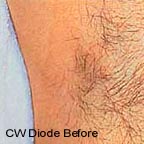
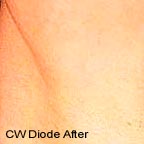
Why should you buy a
Photo Epilation System?
If you suffer from unwanted
hair growth and want a
no-nonsense, easy and fast
answer, this is your solution.
If you are a professional (or
planning to enter the industry
of epilation cosmetology) the
Avance Beauty Diode and IPL Systems have everything needed for success in business.
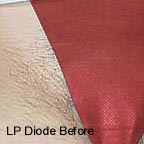
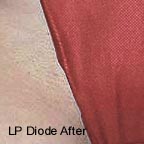
Empirical Evidence/Clinical Study Introduction
The following study reports treatment using the semiconductor diode laser system, a high power, long pulsed diode with a wavelength of 808nm for laser hair reduction.
Laser hair removal operates on the principles of selective photothermolysis. This process combines the selective absorption of light energy by the melanin in the hair follicle with suitable fluences and pulse durations to allow selective injury to the hair follicle while sparing skin(1).
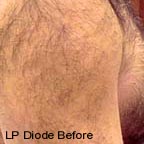
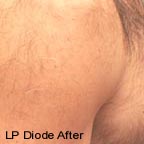
The major 'absorber' of radiation in the skin between 300 and 1200nm is melanin(2), which is found primarily in the epidermis, hair shaft, and hair foll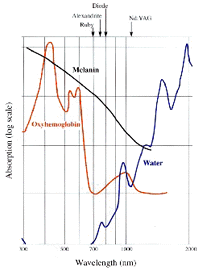 icle. This study was conducted using the 808nm wavelength diode laser for its increased tissue penetration, optimized melanin absorption and safety for treating a wide range of hair diameters/colors and skin types. icle. This study was conducted using the 808nm wavelength diode laser for its increased tissue penetration, optimized melanin absorption and safety for treating a wide range of hair diameters/colors and skin types.
The 808nm wavelength penetrates deeply to reach the germinative cells of the hair bulb and the bulge in even the deepest follicles. The 808nm wavelength appears to be the correct balance, offering safety on darker skin types while providing enough absorption to effectively treat finer and/or lighter hairs.
To achieve selectivity, the laser energy is applied in a pulse duration that approximately equals the thermal relaxation time of the hair shaft, but exceeds the thermal relaxation time of the epidermal melanin. This causes injury to the hair shaft resulting in growth delay and reduction, but allows the heat to dissipate away from the epidermis without causing injury. The semiconductor diode laser system can deliver short pulses or pulse durations up to 100msec. The thermal relaxation time for the hair follicle is dependent upon its diameter; thus longer pulse durations are theoretically best suited for medium to coarse hairs(3) while finer hairs may require shorter pulses.
Clinical studies have shown that aggressive skin cooling allows the use of higher fluences
and results in a greater
margin of safety for all and
especially for darker skin
types(4).
Contact with the patient's
skin after each laser pulse
provides a thermal quenching
effect and additional
epidermal protection.
Methods and Variations of Laser Application
This prospective study looked at hair reduction in 36 healthy subjects (33 women and 3 men) between the ages of 28 and 78 years old. All subjects had tried various hair removal methods in the past without satisfactory results. These methods included shaving, tweezing/plucking, waxing, electrolysis, prescription medications and other hair laser machines. Eligible subjects had black or brown hair, Fitzpatrick skin type I - IV and lacked exclusion criteria. The exclusion criteria included active herpes infection, history of accutane use in the last 12 months, keloid or hypertrophic scarring, photosensivity disorders, severe lentiginous photoaging, compromised skin integrity or HIV infection.
Once the initial screening was completed, the subjects were educated on the potential risks and side effects of laser hair reduction and pre-and post-treatment care. Informed consent was then obtained. Subjects were instructed not to use any other method of hair removal, except shaving or trimming if needed, during the study period. Subjects were asked to return for four sessions, four to eight weeks apart.
Prior to each treatment session, a photograph and hair count was performed on a section marked in a 1cm x 1cm or larger square. The treatment area was cleansed with alcohol and trimmed of any excessively long hairs.
All patients were treated with the semiconductor diode laser system at 808nm wavelength setting. The energy density (J/cm2) and pulse duration (msec) were adjusted according to the subject's Fitzpatrick skin type classification, hair count/hair reduction and skin response. The system is capable of cooling from -2 to 5 degrees Celsius, pulse durations up to 100msec, fluences up to 50J/cm2 and repetition rate up to 4Hz. The area was treated with sufficient energy to elicit follicular edema and erythema within 2 - 5 minutes after laser irradiation. The settings were adjusted with each subsequent treatment if adequate reduction was not evident in the hair count or verbalized by the subject. Topical steroids (class III - V) were applied to the treatment area immediately after each session, with samples provided if needed. Prior to each session, the area was evaluated for skin/hair response and potential complications.
Treatment Efficacy and Overall Results
Eighteen subjects completed three treatment sessions, eight subjects completed two treatment sessions and ten subjects completed only one treatment session. Only one subject had 2 different sites treated (i.e. neck and upper lip). The remaining subjects had only one treatment site, although two hair count measurements were obtained (i.e. both right and left side of the chin or right and left axilla, etc). The average hair reduction of all sites was 41% after the first treatment, 55% after the second treatment and 68% after the third treatment. Hair reduction varied by both treatment site (axilla, face, legs, back, neck, arms, abdomen, and bikini) and number of treatment sessions (1-3). Hair reduction continued to improve with each subsequent treatment. The chin treatment sites appeared to show consistently higher hair reduction measurements than other areas of the face and overall.
References
1. Anderson RR, Parish JA. Selective photothermolysis: precise microsurgery by selective absorption of pulsed radiation. Science 1983; 220: 524-527.
2 Anderson RR, Parkish JA. The optics of human skin. J. Invest. Dermatol 1981;77:13-9.
3. Adrian RM, Tanghetti E. Clinical evaluation of a high energy long-pulse ruby laser for the treatment of unwanted body hair. Lasers Med Surg 1997; supp 9:36.
4. Grossman MC, Dierickx CC, Farinelli WA, Flotte TJ, Anderson RR. Damage to hair follicles by normal-mode ruby laser pulses. J AM Acad Dermatol 1996;35:889.
5. Battle EF. Study of very long-pulsed (100 ms) high powered diode laser for hair reduction on all skin types. Coherent Medical, Santa Clara, CA 2000.
6. Handrick, C., Alster, T. Comparison of long pulsed diode and long pulsed alexandrite lasers for hair removal; A long-term clinical and histologic study Derm Surgery, 2001;27:622-626.
7. Anderson, RR., Laser-tissue interactions. In: Goldman MP, Fitzpatrick RE, editors. Cutaneous laser surgery: the art and science of selective photothermolysis. St. Louis (MO): Mosby-Year Book Inc; 1994. p. 1-18.
|